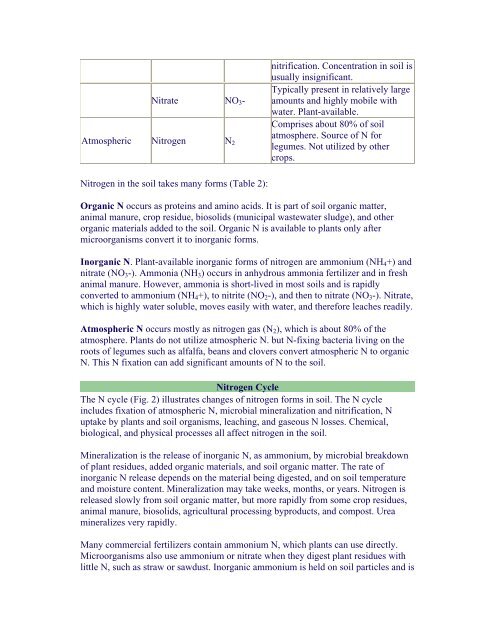eb1722 How Fertilizers and Plant Nutrients Affect Groundwater Quality
eb1722 How Fertilizers and Plant Nutrients Affect Groundwater Quality
eb1722 How Fertilizers and Plant Nutrients Affect Groundwater Quality
You also want an ePaper? Increase the reach of your titles
YUMPU automatically turns print PDFs into web optimized ePapers that Google loves.
nitrification. Concentration in soil is<br />
usually insignificant.<br />
Nitrate NO 3 -<br />
Typically present in relatively large<br />
amounts <strong>and</strong> highly mobile with<br />
water. <strong>Plant</strong>-available.<br />
Atmospheric Nitrogen N 2<br />
Comprises about 80% of soil<br />
atmosphere. Source of N for<br />
legumes. Not utilized by other<br />
crops.<br />
xx<br />
Nitrogen in the soil takes many forms (Table 2):<br />
Organic N occurs as proteins <strong>and</strong> amino acids. It is part of soil organic matter,<br />
animal manure, crop residue, biosolids (municipal wastewater sludge), <strong>and</strong> other<br />
organic materials added to the soil. Organic N is available to plants only after<br />
microorganisms convert it to inorganic forms.<br />
Inorganic N. <strong>Plant</strong>-available inorganic forms of nitrogen are ammonium (NH 4 +) <strong>and</strong><br />
nitrate (NO 3 -). Ammonia (NH 3 ) occurs in anhydrous ammonia fertilizer <strong>and</strong> in fresh<br />
animal manure. <strong>How</strong>ever, ammonia is short-lived in most soils <strong>and</strong> is rapidly<br />
converted to ammonium (NH 4 +), to nitrite (NO 2 -), <strong>and</strong> then to nitrate (NO 3 -). Nitrate,<br />
which is highly water soluble, moves easily with water, <strong>and</strong> therefore leaches readily.<br />
Atmospheric N occurs mostly as nitrogen gas (N 2 ), which is about 80% of the<br />
atmosphere. <strong>Plant</strong>s do not utilize atmospheric N. but N-fixing bacteria living on the<br />
roots of legumes such as alfalfa, beans <strong>and</strong> clovers convert atmospheric N to organic<br />
N. This N fixation can add significant amounts of N to the soil.<br />
xx<br />
Nitrogen Cycle<br />
The N cycle (Fig. 2) illustrates changes of nitrogen forms in soil. The N cycle<br />
includes fixation of atmospheric N, microbial mineralization <strong>and</strong> nitrification, N<br />
uptake by plants <strong>and</strong> soil organisms, leaching, <strong>and</strong> gaseous N losses. Chemical,<br />
biological, <strong>and</strong> physical processes all affect nitrogen in the soil.<br />
Mineralization is the release of inorganic N, as ammonium, by microbial breakdown<br />
of plant residues, added organic materials, <strong>and</strong> soil organic matter. The rate of<br />
inorganic N release depends on the material being digested, <strong>and</strong> on soil temperature<br />
<strong>and</strong> moisture content. Mineralization may take weeks, months, or years. Nitrogen is<br />
released slowly from soil organic matter, but more rapidly from some crop residues,<br />
animal manure, biosolids, agricultural processing byproducts, <strong>and</strong> compost. Urea<br />
mineralizes very rapidly.<br />
Many commercial fertilizers contain ammonium N, which plants can use directly.<br />
Microorganisms also use ammonium or nitrate when they digest plant residues with<br />
little N, such as straw or sawdust. Inorganic ammonium is held on soil particles <strong>and</strong> is

















